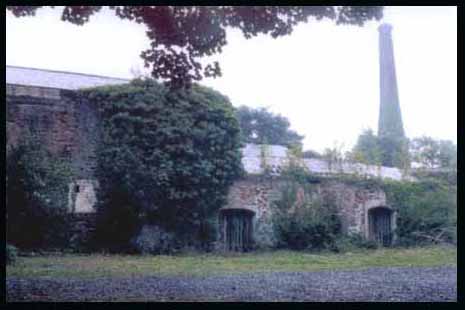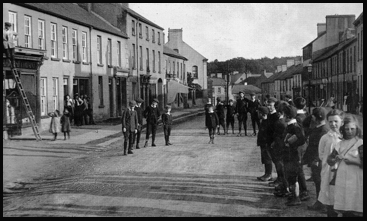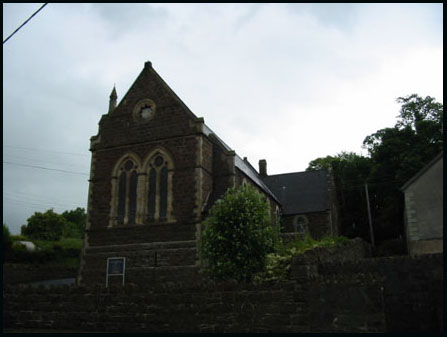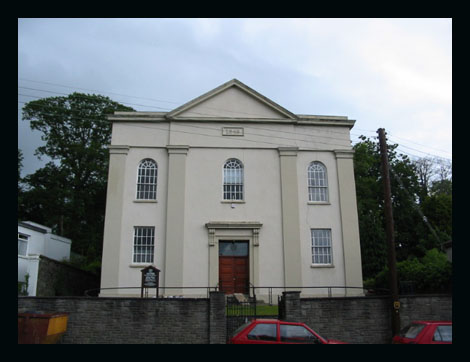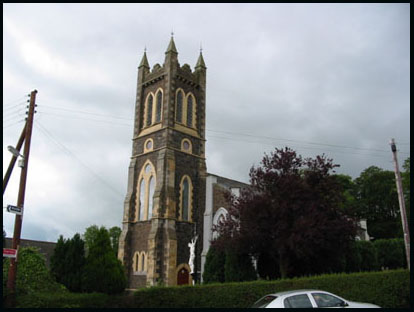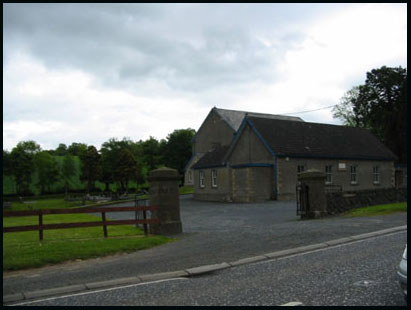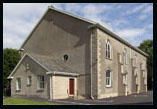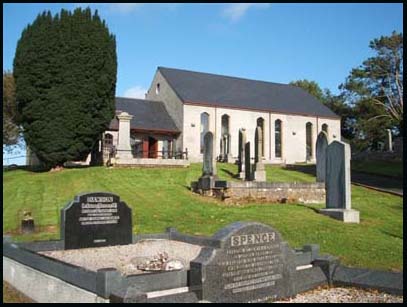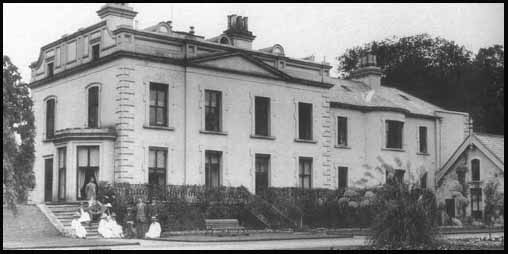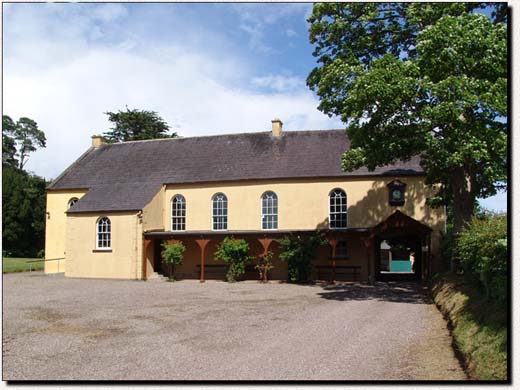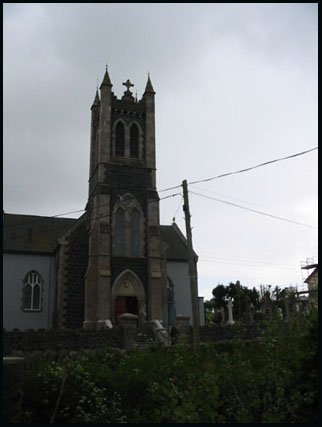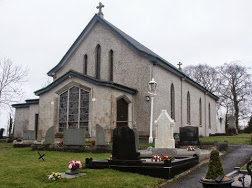|
|
|
|
|
|
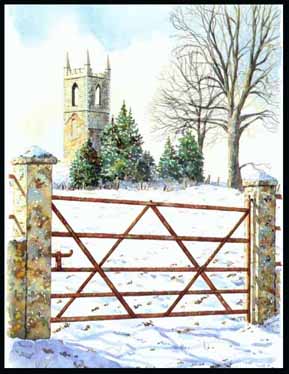 |
|
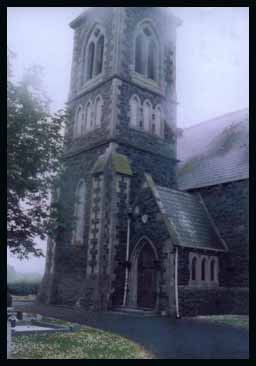 |
Church
of Ireland, All Saints
in Tullylish village
The old parish church (left)
is situated in the townland of Tullylish, about 2 km from Gilford
town on the site of an ancient earthern fort. The first recorded
pastor was in 1526. It was rebuilt in 1698 and abandoned in 1861
having been partially destroyed in the 1641 rebellion. It was
described in 1836 as a very old building but was enlarged at the
expense of the parish by an advance from the Board of First fruits.
It could hold 600 people and was generally very full. It was described
as a neat, stone building with a low tower but without a spire.
The inside was neat and fitted up with pews.
It is in the diocese of Dromore;
the rectory and vicarage, patron the bishop. The vicar 1795- 1813
was Rev. Charles Hamilton & the incumbent in 1824 was Rev.
Thomas Beatty, in 1836 Rev. William Henry Wynne and the Very Rev.
James Mahon; The glebe is 30 Irish acres; Rev. William H. Wynne
had the vicarial tithes and Rev. James Mahon rectorial tithes;
Mr. Wynne was the rector of the townlands of Bleary, Clare, Ballynagarrick
and Ballydugan. In 1846 the rector was Rev. William Butler Yeates.
|
|
|
|
|
The old church was abandoned in
1861 when the new church (right) was built. During the excavation work
for the new church, archaeologists uncovered much of the remains of
an important early Monastic settlement dating back to the 6th century.
It was probably built to protect the pass across the River Bann. Rev.
W.B. Yeats erected the church but was too ill to attend the laying of
the foundation stone. A plaque in the new church commemorated W.B. Yeats;
not the poet but his grandfather .The foundation stone was laid by Alexander
John Robert Stewart, Hugh Sheriff of Co. Down. It was described at the
time as being a fine large building, which cost £3500 and capable
of seating 900 people. It is in the pointed style of the 13th century
but successfully combining pointed, curved and arched Gothic architecture.
Newspaper articles from Down
Recorder;
scriptural school 4 Dec 1847; foundation stone of new church 23 Mar
1861;
Records from 1820, gravestone inscriptions
available UHF Vol 20; The ruin of the old church still stands in the
graveyard where the oldest stone dates from 1703
From Tullylish Parish Records
1792
At a Vestry held in the Parish Church of Tullylish on Friday, August
3rd for the purpose of taking into consideration the necessary repair
of the bridge of Tullylish, the minister, church wardens and parishioners
present came to the following resolution;-
Resolved that the bridge of Tullylish has reason for repair.
Resolved that this Vestry has agreed to the proposal of Thomas Dawson
Lawrence Esq. to repair the bridge in the following manner-
The bridge to be made twelve feet wide a, raised twelve inches, soiled
and gravelled.
Resolved that Mr. Lawrence does agree with the parish to keep the bridge
thus repaired in sufficient order and repair during the timer or term
of fifteen years and at the expiration of said term to deliver the same
to the Parish in sufficient repair and not to take away or alter any
improvements made thereon.
Resolved that the Parish do agree to pay Mr. Lawrence the sum of £5
per annum for and during the term of fifteen years to enable him to
repair the bridge and keep it in proper order and condition during that
time.
Resolved that the Bridge be left in repair satisfactory to the parish.
Resolved that the first payments be made at the next Easter Vestry.
Signed; A. Johnston, Curate; Bruce Crozier, William Thompson & Richard
Johnston Churchwardens.
I do hereby agree to the above (Signed) T. Dawson Lawrence
3rd August 1792
Tullylish Parish Records 1798
At a Vestry called and held in the Parish Church of Tullylish on Sunday
April 10th, 1798, the minister, churchwardens and parishioners present
came to the following resolutions;-
Resolved that Henry Sands of Ballydugan and Brice Crozier of Loughans
be appointed Church Wardens for the present year.
John Sugden the church warden came forward and paid off his part of
the cess £10 and he is allowed until Whitsuntide to settle the
remainder.
Also Mr. Joseph Law is allowed until Whitsuntide to settle his accounts.
Resolved that the cess for the present years be one penny per acre.
Resolved that it be the suggestion of the Vestry that the churchyard
be enclosed with a ditch.
Resolved tact Mr. John Sugden be allowed £5 out of that sum of
£ 16.4.2 which it appears to this vestry he had expended on the
maintenance of Blind Cormac's children.
Resolved that the sum of £4.12.11 be paid to Mr. Wesley being
the deficiency of the sum which he expended in rebuilding the bridge.
Resolved that the surplus of the cess after paying the above sums be
applied to repair the church.
Signed Edward Berwick , vicar; A. Johnston, Curate; Joseph Law, John
Sefton, James Wesley, John Sugden churchwardens.
TPHS p 9,10
List of rectors of the parish.
1526 Arthur McGinn; 1539 Thomas McCormack; 1603 Isaac Plume; 1609 William
Todd; 1621 Hugh Sims; 1621 Thomas Wilson; 1622 John Wall; 1623 Robert
Dawson; 1628 William Moore; 1634 George Synge; 1638 Robert Forward;
1642 Nicholas Greaves; 1673 John Jones; 1679 Henry Jenny; 1687 Oliver
Gardiner; 1713 Henry Jenny;1742 Arthur Chicester; 1758 John Standish;
1765 Jeremiah Seaver; 1775 John Beatty; 1777 Hugh Darley; 1787 Edward
Berwick; 1795 Charles Hamilton; 1813 Thomas Beatty; 1829 William Henry
Wynne; 1836 William Butler Yeats; 1862 Stephen Hastings Atkins; 1873
Richard Rutledge Kane; 1882 Alexander Roderick Ryder; 1888 John McNeece;
1891 William L. Twist- Whatham; 1896 & 1910- 1956 was Edward Albert
Myles.
LDS Libraries have the church
records from 1820-1833; PRONI has Baptisms, 1820-83; marriages,
1820-48; burials, 1829-33 and 1849-85; vestry minutes and accounts,
1792-1960. MIC.1/70-71; Register of vestrymen, 1870-; preachers'
books, 1879 in local custody
gravestone inscriptions UHF Vol
20; oldest stone 1703; email me for a gravestone lookup ; church website
at
http://www.tullylish.co.uk/default.aspx
|
